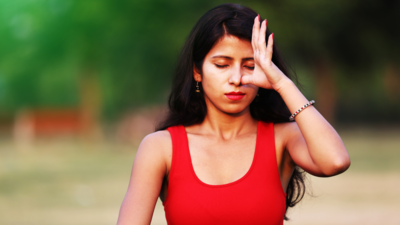- News
- lifestyle
- health-fitness
- fitness
- 6 yoga asanas that can prevent hair fall and strengthen hair
Trending
6 yoga asanas that can prevent hair fall and strengthen hair
Yoga breathing exercises known as pranayama can potentially improve scalp health by enhancing blood circulation and reducing stress. Techniques like Bhramari Pranayama, Kapalabhati Pranayama, Anulom Vilom, Ujjayi Pranayama, and Nadi Shodhana are suggested. While beneficial for overall well-being, these practices should not replace medical advice for specific hair or scalp concerns.

Pranayama for scalp health
Yoga breathing exercises, also known as pranayama, can be beneficial for oxygenating the blood and potentially nourishing the scalp. These practices not only improve overall circulation but also help reduce stress, which can have positive effects on hair health. Here are some yoga breathing techniques that may be particularly helpful:
Bhramari Pranayama (Bee breath)
This technique involves making a humming sound while exhaling, which can increase oxygen in the body and improve blood circulation to the head and scalp.

Kapalabhati Pranayama (Skull shining breath)
According to Himalayan Siddhaa Akshar, yoga guru, founder, Akshar Yoga Kendraa, “This energizing breath involves forceful exhalations and passive inhalations. It's believed to cleanse the respiratory system and increase blood flow to the brain and scalp. Begin by sitting comfortably with a straight spine. Take a deep breath in, then exhale forcefully through your nose while pulling your navel towards your spine. Allow your inhale to happen passively as your abdomen relaxes. Repeat this cycle at a steady pace for 30 seconds to a minute.”
Anulom Vilom (Alternate nostril breathing)
This balancing breath can help improve overall circulation and reduce stress. Sit in a comfortable position and use your right thumb to close your right nostril. Inhale deeply through your left nostril, then close it with your ring finger. Open your right nostril and exhale slowly. Inhale through the right nostril, close it, open the left nostril, and exhale. This completes one cycle. Continue for 5-10 minutes.
Ujjayi Pranayama (Victorious breath)
Also known as the ocean breath, this technique involves slightly constricting the throat to create a soft, audible sound while breathing. It can help increase oxygenation and improve circulation throughout the body. Inhale deeply through your nose, then exhale slowly through a slightly narrowed throat, creating a gentle "ha" sound. This breath can be practiced for several minutes and is often used during yoga asana practice.
According to Yogacharya Akhil Gore, founder RouteIn Yoga, "Pranayama, the ancient yogic practice of breath control, offers significant benefits for scalp health. By improving blood circulation and oxygen flow to the scalp, pranayama nourishes hair follicles, promoting healthier hair growth. Techniques like Anulom Vilom (alternate nostril breathing) and Kapalbhati (skull-shining breath) help detoxify the body, reduce stress, and balance hormones—factors that can contribute to hair thinning or loss. Regular practice of pranayama can also alleviate scalp conditions such as dandruff or dryness by improving overall scalp health and reducing inflammation, making it a natural, holistic way to support hair care."
Nadi Shodhana (Subtle energy cleansing breath)
Similar to Anulom Vilom, this technique is believed to balance the subtle energies in the body and improve overall circulation. The main difference is that you start with the left nostril instead of the right. Begin by closing your right nostril with your right thumb, inhale through the left nostril, then close the left nostril with your ring finger, open the right nostril, and exhale. Inhale through the right nostril, switch, and exhale through the left. Continue for 5-10 minutes.

When practicing these breathing exercises, it's important to maintain a comfortable, upright posture to allow for optimal breath flow. Start with just a few minutes of practice and gradually increase the duration as you become more comfortable with the techniques. Remember to breathe smoothly and never force or strain your breath.
Incorporating these yoga breathing exercises into your daily routine may help improve blood oxygenation and circulation to the scalp, potentially supporting hair health. However, it's important to note that while these practices can be beneficial for overall well-being, they should not be considered a substitute for medical treatment if you have specific hair or scalp concerns. Always consult with a healthcare professional for personalized advice.
5 Easy to do yoga asanas to reduce blood sugar levels
End of Article
FOLLOW US ON SOCIAL MEDIA










